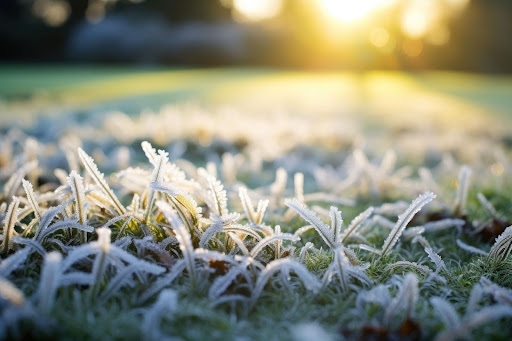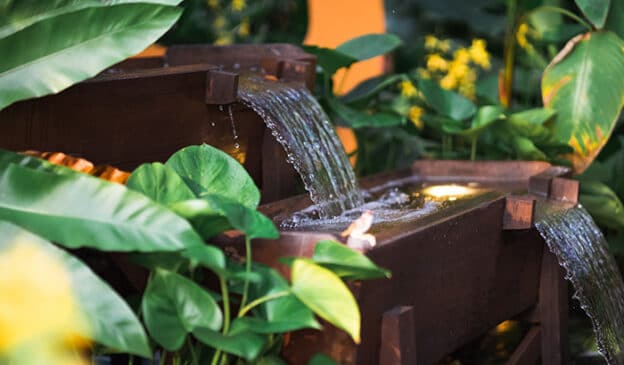It’s not a widely known fact, but winter lawn care is as crucial as spring, summer, or fall lawn care. While your lawn’s needs change with the seasons, its need for care does not. Winter brings unique challenges and opportunities for your lawn.
Seasonal lawn care is about adapting to the changing needs of your grass and soil. In winter, this means protecting and preparing your lawn to withstand the cold and harsh conditions. It’s a time for fortification and maintenance. This guide is dedicated to helping you understand the essentials of winter lawn care, ensuring your lawn stays protected and nourished during these colder months.
Understanding winter lawn care
Winter presents a unique set of challenges for your lawn. As temperatures drop, your lawn enters a dormant phase. This dormancy is a natural protection mechanism, but it doesn’t mean your lawn is invulnerable. In fact, the cold, frost, and snow cover can stress your lawn and affect its health and vitality.
Unlike the active growth periods of spring and summer, where lawn care focuses on fostering growth and vitality, winter lawn care is about maintenance and protection. Winter care involves practices like adjusting your mowing height before the first frost, reducing watering schedules, and applying the right kind of fertilizer to prepare your lawn for the cold.
Understanding and responding to these seasonal needs ensures that your lawn remains healthy throughout the year and is ready to thrive once spring arrives.
Preparing your lawn for winter
Preparing your lawn for winter is crucial in ensuring its health and beauty for the coming spring. As the days shorten and the temperature drops, your lawn requires a different kind of attention. Here are the essential steps to prepare your lawn for the cold months ahead:
Aeration
Aerating your lawn involves creating small holes in the soil to allow air, water, and nutrients to penetrate the grass roots. Aeration helps to reduce soil compaction, a common problem after a busy summer of lawn activity. It also improves drainage, reducing the risk of waterlogging during wet winter months.
Fertilization
Applying the right fertilizer in the fall prepares your lawn for winter. A winter fertilizer typically has a higher concentration of potassium, which strengthens the grass against cold and disease. This step helps to replenish nutrients lost over the summer and provides the energy needed for your lawn to survive the winter.
Mowing height adjustments
As winter approaches, gradually lower the cutting height of your mower. However, be careful not to cut the grass too short, as this exposes the roots to extreme conditions and increases the risk of frost damage. The ideal height is about 2 to 2.5 inches, which is short enough to prevent matting under snow but long enough to protect the roots.
Protecting from winter stressors
Clear your lawn of leaves, debris, and toys before the snow falls. Objects left on the lawn will create dead spots. Additionally, avoid walking on your frosted or snow-covered lawn as much as possible. Foot traffic on a frozen lawn breaks grass blades and leads to bare spots in spring.

Winter watering techniques
Correctly watering your lawn in winter is a delicate balance. The goal of winter watering is to maintain enough moisture to prevent desiccation. While your lawn’s water requirements decrease as it enters dormancy, it’s important to ensure it still receives adequate moisture. Here are some key tips for effective winter watering:
Monitor weather conditions
Winter watering should be based on the weather and the condition of your lawn. Your lawn will need supplemental watering if you’re experiencing an unusually dry winter with little to no snowfall. However, if there’s regular snowfall, nature is likely providing enough moisture.
Water when temperatures are mild
Choose a warm day when the temperature is above freezing to water your lawn. This helps prevent the water from freezing on the grass blades and damaging them. The best time to water is midday when temperatures are at their highest.
Avoid overwatering
Overwatering in winter is as detrimental as underwatering. Excess water sometimes freezes and creates ice layers that suffocate the grass. Too much water also causes mold and disease. Water only when the soil is dry to the touch and there’s no precipitation in the forecast.
Use the right equipment
Consider using a soaker hose or a controllable sprinkler system. These offer even distribution of water, which prevents overwatering in certain areas.
Managing weeds and pests in winter
Winter might seem like a time when your lawn gets a break from weeds and pests, but that’s not necessarily true. Some weeds and pests survive and even thrive in winter, posing a threat to the health of your lawn. Here’s how to manage these challenges effectively:
Identifying common winter weeds and pests
Winter weeds like chickweed, annual bluegrass, and henbit often emerge during mild winter days, taking advantage of your lawn’s dormant state. As for pests, grubs and certain types of mites may remain active.
Strategies for managing weeds and pests:
- Proper lawn maintenance: Maintaining a healthy lawn is your first line of defense. A well-aerated, fertilized, and mowed lawn is less susceptible to weeds and pests.
- Regular monitoring: Regularly inspect your lawn for signs of weed growth or pest activity. Early detection leads to effective control.
- Manual removal: For small infestations, hand-pulling weeds is usually effective. Remove the entire root to prevent regrowth.
- Targeted treatments: For persistent weed problems, consider spot treatments with a selective herbicide that targets weeds without harming your grass. For winter pests, identify the specific type and treat accordingly with the appropriate insecticide.
Safe and effective treatment options:
Always choose treatments that are safe for your lawn and the environment. Opt for organic or natural herbicides and pesticides when possible. If using chemical treatments, follow the instructions carefully and apply them during appropriate weather conditions to maximize effectiveness and minimize environmental impact.
Winter lawn repair and maintenance
Winter might be tough on your lawn, but with the right repair and maintenance techniques, you can ensure it remains healthy and recovers quickly from any damage.
Repairing winter damage:
- Addressing snow mold: After the snow melts, you might find patches of moldy-looking grass, known as snow mold. Gently rake these areas to promote air circulation and help the grass recover.
- Repairing salt damage: If you’ve used salt for de-icing, it can harm the grass near driveways and walkways. In early spring, flush these areas with water to dilute salt concentration and reseed if necessary.
- Fixing physical damage: Areas of the lawn that have been compacted by foot traffic or heavy snow should be aerated in the spring to encourage new growth.
Routine maintenance tips:
- Regular inspections: Even in winter, it’s important to inspect your lawn regularly for signs of distress or disease. This proactive approach allows for early intervention, which helps prevent major damage.
- Timely interventions: If you notice any issues, address them promptly. Whether it’s reseeding thin areas or adjusting your watering schedule, timely interventions make a significant difference.
- Maintaining equipment: Ensure your lawn care equipment, especially mowers and aerators, are well-maintained and ready for use when the growing season begins.
The health of your lawn in winter is a precursor to its spring vitality. By taking these steps to repair any winter damage and maintain your lawn, you’re setting the stage for a lush, green lawn as the warmer weather returns. Regular inspections and timely interventions help to identify and address issues before they become major problems.

Protecting your lawn from winter elements
Winter’s snow, frost, and icy conditions are challenging. However, with the right seasonal lawn care strategies, you’ll protect your lawn and ensure its resilience. Here are effective ways to shield your lawn from harsh winter elements:
Use protective coverings
Consider burlap or frost blankets for smaller, delicate areas of your lawn or newly seeded patches. These coverings offer protection against frost and heavy snow while still allowing the grass to breathe.
Manage snow piles
When shoveling or plowing, distribute snow evenly across your lawn. Avoid large piles of snow, as they can take longer to melt and may smother the grass underneath.
Balance exposure
While it’s important to protect your lawn, it also needs exposure to air and light, even in winter. Remove any debris, leaves, or branches that may accumulate, as these often create wet, moldy conditions.
By implementing these strategies, you effectively balance your lawn’s exposure to winter elements with its overall health, ensuring it emerges in spring ready for new growth and vitality.
Comprehensive lawn care and landscaping by LaytonScape
As we’ve discussed, effective winter lawn care is essential for ensuring a healthy, vibrant lawn come spring. From proper watering and weed management to protecting your lawn from the harsh winter elements, each step is crucial in maintaining your lawn’s health during the colder months.
If you’re looking for personalized advice or professional assistance, Laytonscape is here to help. Our team of experts is dedicated to providing comprehensive lawn care solutions tailored to your specific needs.
Contact LaytonScape today to ensure your lawn receives the best care possible this winter. Let’s work together to keep your lawn thriving all year round.



